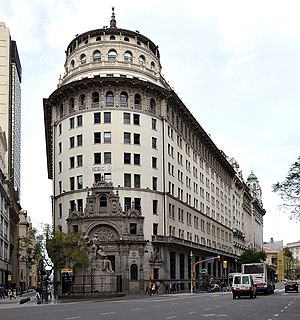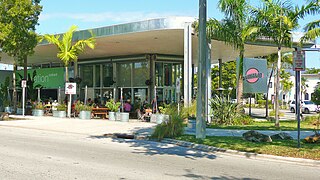Related Research Articles

The architecture of the United States demonstrates a broad variety of architectural styles and built forms over the country's history of over two centuries of independence and former Spanish and British rule.

The Spanish Colonial Revival Style is an architectural stylistic movement arising in the early 20th century based on the Spanish Colonial architecture of the Spanish colonization of the Americas.

In architecture and city planning, a terrace or terraced house (UK) or townhouse (US) is a form of medium-density housing that originated in Europe in the 16th century, whereby a row of attached dwellings share side walls. In the United States they are also known as row houses or row homes, found in older cities such as Philadelphia and Baltimore.

The City Beautiful Movement was a reform philosophy of North American architecture and urban planning that flourished during the 1890s and 1900s with the intent of introducing beautification and monumental grandeur in cities. It was a part of the progressive social reform movement in North America under the leadership of the upper-middle class concerned with poor living conditions in all major cities. The movement, which was originally associated mainly with Chicago, Cleveland, Detroit, Kansas City and Washington, D.C., promoted beauty not only for its own sake, but also to create moral and civic virtue among urban populations. Advocates of the philosophy believed that such beautification could promote a harmonious social order that would increase the quality of life, while critics would complain that the movement was overly concerned with aesthetics at the expense of social reform; Jane Jacobs referred to the movement as an "architectural design cult."

Homelessness in the United States refers to the issue of homelessness, a condition wherein people lack "a fixed, regular, and adequate nighttime residence" as defined by The McKinney–Vento Homeless Assistance Act. Point-in-time single night counts prepared by shelter providers differ greatly from federal government accounts. In 2014, approximately 1.5 million sheltered homeless people were counted. The federal government statistics are prepared by the United States Department of Housing and Urban Development's Annual Homeless Assessment Report; as of 2018, HUD reported there were roughly 553,000 homeless people in the United States on a given night, or 0.17% of the population. Annual federal HUD reports contradict private state and local reports where homelessness is shown to have increased each year since 2014 across several major American cities, with 40 percent increases noted in 2017 and in 2019. In January 2018 the federal government statistics gave comprehensive encompassing nationwide statistics, with a total number of 552,830 individuals, of which 358,363 (65%) were sheltered in provided housing, while some 194,467 (35%) were unsheltered.

Kalorama is a neighborhood in Northwest Washington, D.C., United States. It includes the Kalorama Triangle Historic District and Sheridan-Kalorama Historic District. It is named after the Kalorama mansion.

Ranch is a domestic architectural style that originated in the United States. The ranch-style house is noted for its long, close-to-the-ground profile, and wide open layout. The style fused modernist ideas and styles with notions of the American Western period of wide open spaces to create a very informal and casual living style. While the original ranch style was informal and basic in design, ranch-style houses built in the United States from around the early 1960s increasingly had more dramatic features such as varying roof lines, cathedral ceilings, sunken living rooms, and extensive landscaping and grounds.

California bungalow is an alternative name for the American Craftsman style of residential architecture, when it was applied to small-to-medium sized homes rather than the large "ultimate bungalow" houses of designers like Greene and Greene. California bungalows became popular in suburban neighborhoods across the United States, and to varying extents elsewhere, from around 1910 to 1939.

Mediterranean Revival is an architectural style introduced in the United States in the waning nineteenth century variously incorporating references from Spanish Renaissance, Spanish Colonial, Italian Renaissance, French Colonial, Beaux-Arts, Arabic Andalusian architecture, and Venetian Gothic architecture.

American Craftsman is an American domestic architectural style, inspired by the Arts and Crafts movement, which included interior design, landscape design, applied arts, and decorative arts, beginning in the last years of the 19th century. Its immediate ancestors in American architecture are the Shingle style, which began the move away from Victorian ornamentation toward simpler forms; and the Prairie style of Frank Lloyd Wright. The name "Craftsman" was appropriated from furniture-maker Gustav Stickley, whose magazine The Craftsman was first published in 1901. The architectural style was most widely-used in small-to-medium-sized Southern California single-family homes from about 1905, so that the smaller-scale Craftsman style became known alternatively as "California bungalow". The style remained popular into the 1930s, and has continued with revival and restoration projects through present times.

The Upper Eastside is a neighborhood in Miami, Florida, United States. It is north of Edgewater, east of Little Haiti, south of the village of Miami Shores, and sits on Biscayne Bay. In geographical order from south to north and east to west, it contains the subdivisions of Magnolia Park, Bay Point, Morningside, Bayside, Belle Meade, Shorecrest, and Palm Grove. The MiMo District along Biscayne Boulevard in the area is host to many art galleries, shops and restaurants.

George Washington Smith was an American architect and painter. He is known particularly for his work around Santa Barbara, California, and for popularizing the Spanish Colonial Revival style in early 20th Century America. His notable works include Casa del Herrero, the Lobero Theater, the Santa Barbara News-Press building, and buildings at the Santa Barbara Cemetery.

The architecture of St. Louis exhibits a variety of commercial, residential, and monumental architecture. St. Louis, Missouri is known for the Gateway Arch, the tallest monument constructed in the United States. Architectural influences reflected in the area include French Colonial, German, early American, European influenced, French Second Empire, Victorian, and modern architectural styles.
In the United States, the National Register of Historic Places classifies its listings by various types of architecture. Listed properties often are given one or more of 40 standard architectural style classifications that appear in the National Register Information System (NRIS) database. Other properties are given a custom architectural description with "vernacular" or other qualifiers, and others have no style classification. Many National Register-listed properties do not fit into the several categories listed here, or they fit into more specialized subcategories.

The architecture of Jacksonville is a combination of historic and modern styles reflecting the city's early position as a regional center of business. According to the National Trust for Historic Preservation, there are more buildings built before 1967 in Jacksonville than any other city in Florida, but it is also important to note that few structures in the city center predate the Great Fire of 1901. Numerous buildings in the city have held state height records, dating as far back as 1902, and last holding a record in 1981.

Historic Hotels of America is a program of the National Trust for Historic Preservation that was founded in 1989 with 32 charter members; the programs accepts nominations and identifies hotels that have maintained their authenticity, sense of place, and architectural integrity. As of June 5, 2015, the program included over 260 members in 44 states, including the District of Columbia, Puerto Rico, and the U.S. Virgin Islands.

Housing in Wisconsin is mainly based on detached homes. Additional kinds of housing include multiple-unit buildings, typically owned by a corporation or individual. Several home styles have been popular, including ranch and split-level houses.

Housing in the United States includes both detached homes and apartment buildings. Housing is a vital economic sector, contributing to 15% of the GDP. For regional details, see also housing in the United States by state.

Housing in Washington, D.C. encompasses a variety of shelter types: apartments, single family homes, condominiums, co-ops, and apartments considered public housing. Washington, D.C. is considered one of the most expensive cities in which to live in the United States — in 2019, it was ranked in the top 10 of American cities with the most expensive homes.

Housing in Florida consists of apartments, condominiums, hotels, retirement communities, and houses. Common types of housing in the state include Cracker style homes, Ranch-style homes, Caribbean style homes, and Condominiums with styles including Spanish Colonial Revival architecture, Victorian architecture, Mediterranean Revival architecture, Art Deco, Modern architecture, and Pueblo Revival architecture.
References
- ↑ Comments, ·19. "Florida Saw The Biggest Fall In Homeless Population Nationwide Since 2007, Feds Say". The Next Miami. Retrieved 2021-11-17.CS1 maint: numeric names: authors list (link)
- ↑ Stith, D.J.; Meyer, R.P. (1974). Styles and designs in Wisconsin housing: pros and cons of popular house plans.